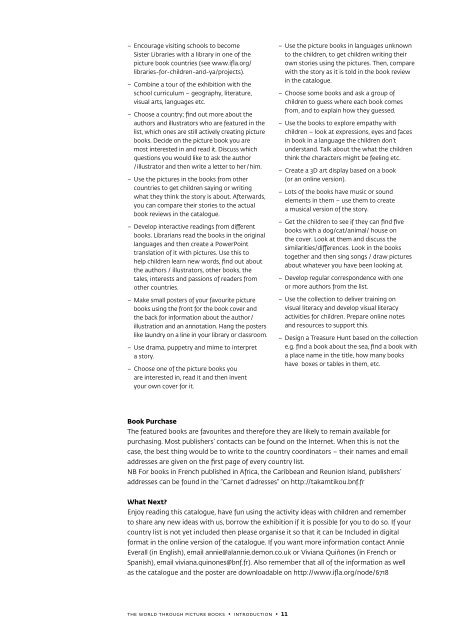world_pictures
world_pictures
world_pictures
Create successful ePaper yourself
Turn your PDF publications into a flip-book with our unique Google optimized e-Paper software.
– Encourage visiting schools to become<br />
Sister Libraries with a library in one of the<br />
picture book countries (see www.ifla.org/<br />
libraries-for-children-and-ya/projects).<br />
– Combine a tour of the exhibition with the<br />
school curriculum – geography, literature,<br />
visual arts, languages etc.<br />
– Choose a country; find out more about the<br />
authors and illustrators who are featured in the<br />
list, which ones are still actively creating picture<br />
books. Decide on the picture book you are<br />
most interested in and read it. Discuss which<br />
questions you would like to ask the author<br />
/ illustrator and then write a letter to her / him.<br />
– Use the <strong>pictures</strong> in the books from other<br />
countries to get children saying or writing<br />
what they think the story is about. Afterwards,<br />
you can compare their stories to the actual<br />
book reviews in the catalogue.<br />
– Develop interactive readings from different<br />
books. Librarians read the books in the original<br />
languages and then create a PowerPoint<br />
translation of it with <strong>pictures</strong>. Use this to<br />
help children learn new words, find out about<br />
the authors / illustrators, other books, the<br />
tales, interests and passions of readers from<br />
other countries.<br />
– Make small posters of your favourite picture<br />
books using the front for the book cover and<br />
the back for information about the author /<br />
illustration and an annotation. Hang the posters<br />
like laundry on a line in your library or classroom.<br />
– Use drama, puppetry and mime to interpret<br />
a story.<br />
– Choose one of the picture books you<br />
are interested in, read it and then invent<br />
your own cover for it.<br />
– Use the picture books in languages unknown<br />
to the children, to get children writing their<br />
own stories using the <strong>pictures</strong>. Then, compare<br />
with the story as it is told in the book review<br />
in the catalogue.<br />
– Choose some books and ask a group of<br />
children to guess where each book comes<br />
from, and to explain how they guessed.<br />
– Use the books to explore empathy with<br />
children – look at expressions, eyes and faces<br />
in book in a language the children don’t<br />
understand. Talk about the what the children<br />
think the characters might be feeling etc.<br />
– Create a 3D art display based on a book<br />
(or an online version).<br />
– Lots of the books have music or sound<br />
elements in them – use them to create<br />
a musical version of the story.<br />
– Get the children to see if they can find five<br />
books with a dog/cat/animal/ house on<br />
the cover. Look at them and discuss the<br />
similarities/differences. Look in the books<br />
together and then sing songs / draw <strong>pictures</strong><br />
about whatever you have been looking at.<br />
– Develop regular correspondence with one<br />
or more authors from the list.<br />
– Use the collection to deliver training on<br />
visual literacy and develop visual literacy<br />
activities for children. Prepare online notes<br />
and resources to support this.<br />
– Design a Treasure Hunt based on the collection<br />
e.g. find a book about the sea, find a book with<br />
a place name in the title, how many books<br />
have boxes or tables in them, etc.<br />
Book Purchase<br />
The featured books are favourites and therefore they are likely to remain available for<br />
purchasing. Most publishers’ contacts can be found on the Internet. When this is not the<br />
case, the best thing would be to write to the country coordinators – their names and email<br />
addresses are given on the first page of every country list.<br />
NB For books in French published in Africa, the Caribbean and Reunion Island, publishers’<br />
addresses can be found in the “Carnet d’adresses” on http://takamtikou.bnf.fr<br />
What Next?<br />
Enjoy reading this catalogue, have fun using the activity ideas with children and remember<br />
to share any new ideas with us, borrow the exhibition if it is possible for you to do so. If your<br />
country list is not yet included then please organise it so that it can be Included in digital<br />
format in the online version of the catalogue. If you want more information contact Annie<br />
Everall (in English), email annie@alannie.demon.co.uk or Viviana Quiñones (in French or<br />
Spanish), email viviana.quinones@bnf.fr). Also remember that all of the information as well<br />
as the catalogue and the poster are downloadable on http://www.ifla.org/node/6718<br />
the <strong>world</strong> through picture books • introduction • 11


